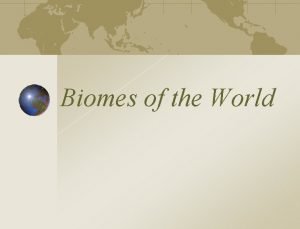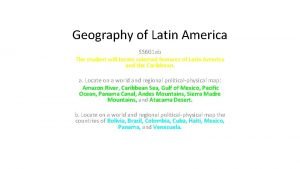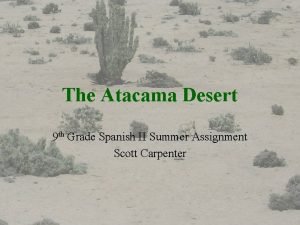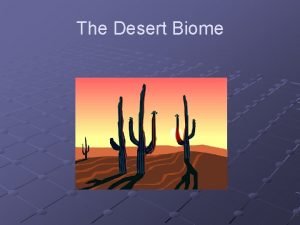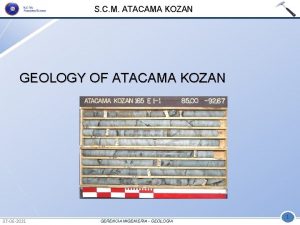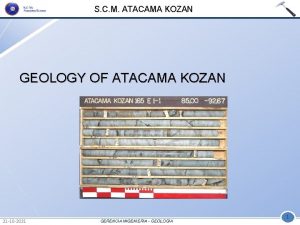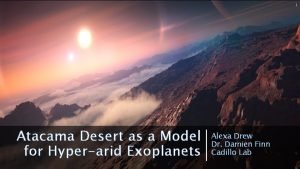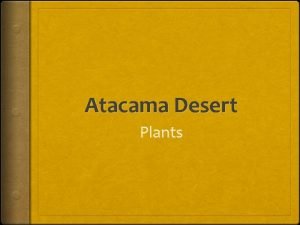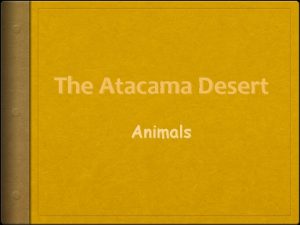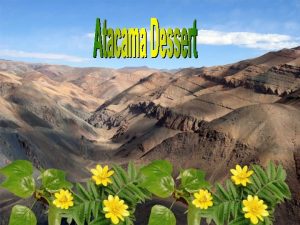The Atacama Desert 9 th Grade Spanish II











- Slides: 11

The Atacama Desert 9 th Grade Spanish II Summer Assignment Scott Carpenter

Location The Atacama Desert is located on the western coast of South America and runs north to south from 18° 24' S near the Peru/Chile border to 29° 55' S latitude. East to west, it runs from the Pacific Ocean all the way up to the Andes Mountains. The desert is approximately 994 miles long and 111 miles wide at its widest point. The mean elevation of this desert is 13000 feet. It is a common misconception that the Atacama Desert runs all the way to the southern tip of Chile. In reality, this is a collection of other small deserts commonly referred to as just ‘the Atacama Desert. ’

Climate “The Atacama Desert is considered to be one of the driest coastal deserts in the world” (www. worldwildlife. org). This desert receives an average of less than. 004 inches of rain per year. In fact, some areas of the Atacama desert have not had rain in nearly 400 years. In some places near the desert, such as the Andes mountains, precipitation falls in the form of snow. The average daily temperature of the Atacama desert varies from 32°F to 77°F as it is a relatively cool desert.

Why is the Atacama Desert so Dry? The Atacama Desert is so dry due to a phenomenon called rain shadow. Any humid tropical air that would normally be brought into the area from the east by the trade winds is stopped by the Andes mountain range. The humid air cools as it reaches the mountains and the water vapor in the air condenses and falls out as precipitation. Due to the high atmospheric pressure in the mountain range, the dry air decompresses and moves into the desert. This makes the Atacama devoid of water. Another contributing factor to the lack of rain in the Atacama is high pressure in the Pacific prevents any rainfall from reaching the desert from the west. Atacama Desert

Plant Life Very few plants can be found in the Atacama Desert. Most of the plants that are able to survive in the desert congregate near streams and where there may be an occasional pool of water. The other areas of the desert are virtually lifeless. The main types of plants that can be found in the Atacama are cacti, perennials, and mesquite. The desert is actually so dry that plant matter does not decompose well and may become hundreds of years old.

Animal Life Like plant life, animal life in the Atacama Desert is very scarce due to lack of water and nutrients. Animals in the desert, like plants, exist near water sources such as streams and oases. These animals include llamas, vicuñas, alpacas, huemel deer, mice, foxes, three species of flamingo, and various birds. However, most of the desert does not contain enough water to support animal life.

Ancient Peoples Archeology shows that the Atacama Desert was once home to various ancient civilizations. One of the most obvious indications of this are the 5000+ geoglyphs carved into the desert floor. These geoglyphs were massive, and depict many different things; from geometric shapes, to people, to llamas, and to amphibians. They were built around 6001600 AD by advanced South American cultures such as the Tiwanaku and Inca, as well as other less advanced peoples. These glyphs provide evidence that people lived here, and although no human remains have been found, paleontologists have found tools such as arrowheads and knives as well as ancient campsites. These campsites are dated at 9000 to 13000 years old.

Mining The Atacama Desert contains the world’s largest sodium nitrate deposits that provided a major source of income until the 1940 s. This was due to the development of synthetic sodium nitrate by the Germans at the turn of the 20 th century. There are now around 170 abandoned nitrate mining facilities all throughout the desert. In addition to sodium nitrate, there also copper and other mineral deposits in the Atacama. While they are not as profitable as nitrate, these minerals also provide profits.

Border Disputes In the 1800 s, border disputes erupted between Chile and Bolivia concerning land in the Atacama Desert. When Bolivia gained independence, they claimed land in the Atacama that was claimed by the Chileans 7 years previously. This caused turmoil between the two countries, and they eventually signed a treaty in 1866 that established the 24 th parallel as the border line, and decided that Chile and Bolivia would share tax revenue from companies operating between the 23 rd and 25 th parallel. Later, the Bolivians raised taxes in this area without Chilean consent, and Chile sent a warship to Bolivian waters. This sparked the War of the Pacific in 1879 in which Chile ultimately defeated Peru and Bolivia to gain control of the Atacama Desert.

People in the Atacama Desert Today in the Atacama Desert, there around a million inhabitants. Most of these are clustered around coastal villages, mining towns, and oasis towns. In addition to these people there are various astronomer teams operating in the Atacama due to the favorable conditions of low moisture content of the air, and the absence of clouds.

Sources • • • • • http: //newsimg. bbc. co. uk http: //www. worldwildlife. org http: //www. wikipedia. org http: //www. extremescience. com http: //www. nathanward. com http: //www. marietta. edu http: //www. gonomad. com http: //www. newworldencyclopedia. org http: //www. bigtravelweb. com http: //www. atacamaphoto. com http: //www. nationalgeographic. com http: //www. buzzle. com http: //www. stanford. edu http: //archaeology. about. com http: //www. nazcamystery. com/images/atacama_small. jpg http: //www. trussel. com http: //1. bp. blogspot. com http: //www. nma. gov http: //www. eso. org **many of the sites listed were used only to obtain pictures, and not for informational uses.
